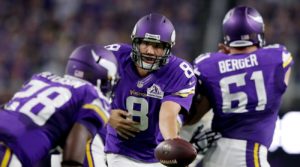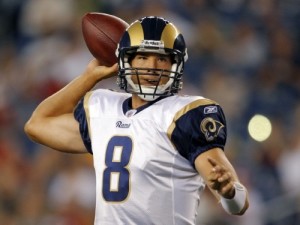What you may not have heard: Bradford also ranked last in the league in passing yards gained per completion, which makes his record-breaking performance a somewhat hollow achievement. Bradford is the fifth quarterback in the Super Bowl era to rank 1st in completion percentage and last in yards per completion, joining David Carr (HOU 2006), Eric Hipple (DET 1986), Joe Montana (SFO 1980) in his first year as a starter, and Sonny Jurgensen (WAS 1969). In general, things didn’t work out well for those quarterbacks: Carr posted a 6-10 record in 2006, while Hipple went 3-7, and Montana went 2-5. Bradford went 7-8 last season, meaning only Jurgensen (7-5-2) posted a winning record of that bunch (and Washington had a negative points differential and faced a very easy schedule that year).
Expand the list to finishing 1st or 2nd in completion percentage and last or 2nd-to-last in yards per completion, and you bring in four more quarterbacks: Chad Pennington (NYJ 2007, 2nd in both), Joe Montana (SFO 1981, 1st in comp%, 2nd-to-last in YPC), Fran Tarkenton (MIN 1977, 1st, 2nd) and Len Dawson (KAN 1972, 2nd in comp%, last in YPC). The results there were mixed: Pennington went 1-7, while Montana went 13-3, Tarkenton went 6-3, and Dawson went 7-5. It is worth pointing out that Montana and Tarkenton both had above-average Y/A ratios that year: in other words, having a high completion percentage is great, but only if it doesn’t come at the expense of your yards per completion average.
How much of a checkdown artist was Bradford last year? He finished 1.95 standard deviations above average in completion percentage last year among qualifying passers, a metric commonly referred to as a Z-score. He also finished 1.82 standard deviations below average in yards per completion. If you take his Z-Score in completion percentage (+1.95), and subtract his Z-Score in yards per completion (-1.82), you get a result of +3.77.
That may not mean much in the abstract, but it ranks as the 3rd most extreme result in the Super Bowl era, behind only Jurgensen 69 and Carr 06. The table below shows the top 200 most extreme checkdown artists — by this metric — since 1966:
As always, please leave your thoughts in the comments. Tomorrow, we’ll look at the opposite result: any guesses as to the leaders in that category?


